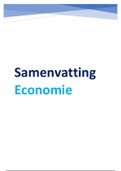Summary
Samenvatting Economie RSM BA1 Literatuur & Colleges
- Course
- Institution
- Book
De gehele tentamenstof van Economie uit jaar 1 is samengevat inclusief de hoofdstukken uit het boek Micro Economics die verplicht zijn. Je haalt je tentamen zeker met deze samenvatting.
[Show more]





